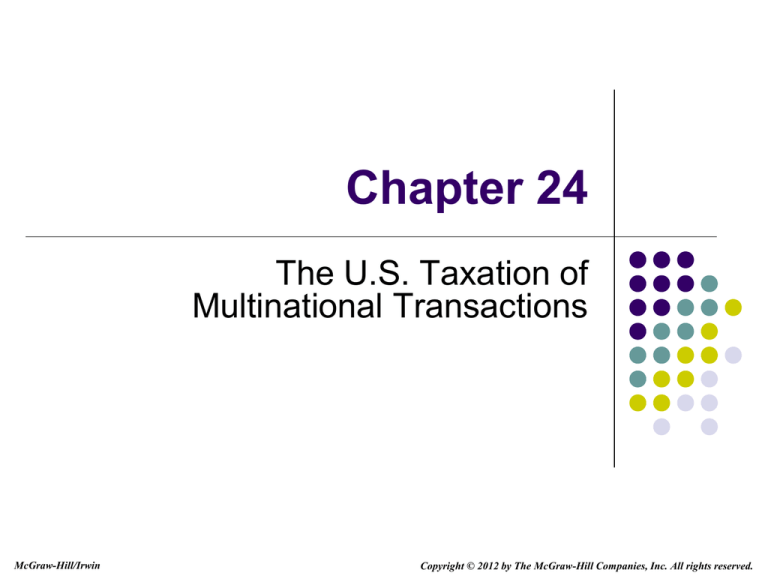
Chapter 24
The U.S. Taxation of
Multinational Transactions
McGraw-Hill/Irwin
Copyright © 2012 by The McGraw-Hill Companies, Inc. All rights reserved.
Learning Objectives
1.
2.
3.
4.
5.
6.
Understand the basic U.S. framework for taxing
multinational transactions and the role of the foreign tax
credit limitation
Apply the U.S. source rules for common items of gross
income and deductions
Recall the role of income tax treaties in international tax
planning
Identify creditable foreign taxes and compute the foreign tax
credit limitation
Distinguish between the different forms of doing business
outside the United States and list their advantages and
disadvantages
Comprehend the basic U.S. anti-deferral tax regime and
identify common sources of subpart F income
24-2
U.S. Framework for Taxing
Multinational Transactions
The U.S. taxes citizens and residents on their
worldwide income and nonresidents on their U.S.
source income.
The criteria chosen to assert the right to tax a
person or transaction is called nexus.
24-3
U.S. Framework for Taxing
Multinational Transactions
Source-based jurisdiction
The United States taxes only the U.S. source income
of non-U.S. residents (individuals and corporations).
Residence-based jurisdiction
The United States taxes the worldwide income of U.S.
citizens and residents (individuals and corporations).
Primary jurisdiction U.S. source income
Residual jurisdiction
non-U.S. source income
24-4
U.S. Framework for Taxing
Multinational Transaction
U.S. Taxation of a Nonresident
U.S. source income earned by a nonresident is
classified into two categories
Effectively connected income (ECI)
Taxed on a net basis using the U.S. graduated tax rates
Fixed and determinable, annual or periodic Income
(FDAP)
Taxed on a gross basis through a flat withholding tax
24-5
U.S. Framework for Taxing
Multinational Transaction
Definition of a resident for U.S. tax purposes
A noncitizen is treated as a U.S. resident alien for
income tax purposes if the individual is a permanent
resident (has a green card) or meets a substantial
presence test.
Substantial presence test
The individual is physically present in the United States
for at least 31 days during the current year, and
Days present in the current year (1/3 number of days
during first preceding year) (1/6 number of days
during the second preceding year) 183.
24-6
U.S. Framework for Taxing
Multinational Transaction
Overview of U.S. foreign tax credit (FTC) system
Double taxation of foreign source income earned by a
U.S. person (U.S. and host country) is mitigated
through the foreign tax credit mechanism.
To preserve the U.S. right to assert primary taxing
jurisdiction over U.S. source income, the foreign tax
credit is limited to the U.S. tax that would have been
paid had the income been earned in the U.S.
The mechanism through which this principle is
achieved is the foreign tax credit limitation.
24-7
U.S. Framework for Taxing
Multinational Transaction
FTC limitation formula
Computed separately for two different categories of
foreign source income
Passive income
General income
A taxpayer can carry any excess FTC for the current
year to the previous tax year (mandatory) and then to
the next 10 future tax years
24-8
U.S. Source Rules for Gross
Income and Deductions
Multinational transactions require taxpayers to
determine the jurisdictional source of their gross
income
Source of income rules
Determine if income or deductions are treated as U.S.
source or foreign source
For a U.S. taxpayer, the source rules primarily
determine foreign taxable income in the calculation of
the FTC limitation
24-9
U.S. Source Rules for Gross
Income and Deductions
For a non-U.S. taxpayer, they determine what income is
subject to U.S. taxation
The source rules are definitional in nature – they do not
impose a tax liability, create income, or allow a
deduction.
24-10
U.S. Source Rules for Gross
Income and Deductions
Interest
General rule: The source of interest income is
determined by the residence of the borrower at the time
the interest is paid.
Although interest income paid by a U.S. bank to a
nonresident is U.S. source income, it is exempt from U.S.
withholding or other income taxation.
This exception is designed to attract foreign capital to
U.S. banks.
24-11
U.S. Source Rules for Gross
Income and Deductions
Dividends
Source of dividend income is determined by the residence
of the corporation paying the dividend
Compensation for services
Source is determined by the location where the service is
performed
Compensation for “labor and personal services” includes
Activities of employees, independent contractors, artists,
entertainers, and athletes.
24-12
U.S. Source Rules for Gross
Income and Deductions
Limited commercial traveler exception
Individual was present in the United States for not more than
90 days during the current taxable year
Compensation for the services does not exceed $3,000
Services are performed for a nonresident alien, foreign
corporation, or foreign partnership or for the foreign office of a
domestic corporation
Treaties often modify the exempt compensation
amounts and the maximum length of stay.
Maximum amount of compensation: Unlimited
Length of stay modification: Not more than 183 days
24-13
U.S. Source Rules for Gross
Income and Deductions
Rents and royalties
Rent has its source where property is generating the rent
is located.
Royalty income has its source where the intangible
property or rights generating the royalty is used.
Gain on the sale of realty is sourced based on where
the property sold is located.
24-14
U.S. Source Rules for Gross
Income and Deductions
Gain or loss from sale of purchased personal property
Has its source based on the seller’s residence
Exception
Gross income from the sale of purchased inventory is
sourced where title passes.
24-15
U.S. Source Rules for Gross
Income and Deductions
Inventory manufactured within the united states and sold
outside the United States (§863 Sales)
Has special apportionment rules found in regulations
issued by the U.S. treasury
50/50 method
Taxpayer sources one-half each for the gross income from
sales based on where the inventory is manufactured and on
where title passes to the inventory.
Provides U.S. manufacturers with the opportunity to “create”
foreign source income on export sales.
24-16
U.S. Source Rules for Gross
Income and Deductions
Source of deduction rules
General principles of allocation and apportionment
Definitely related deductions
Not definitely related deductions
Special apportionment rules
Apply to nine categories of deductions
Interest, research and experimental expenses,
stewardship expenses, supportive expenses, state and
local income taxes, losses on property disposition, legal
and accounting fees, charitable contributions
24-17
Treaties
Treaties are designed to encourage cross-border
trade by reducing the double taxation of such
income by the countries that are parties to the
treaty.
Treaties define when a resident of one country has
nexus in the other country.
Treaties reduce or eliminate the withholding tax
imposed on cross border payments such as
interest, dividends, and royalties.
24-18
Foreign Tax Credits
Only income taxes can be claimed as a credit on
a U.S. tax return.
A U.S. corporation owning 10 percent or more of
a foreign corporation is eligible for an indirect FTC
for taxes paid by the foreign corporation on
dividends paid.
Current year foreign tax credit cannot exceed the
FTC limitation.
24-19
Foreign Tax Credits
Two categories of FTC income
Passive category income
Investment-type income that traditionally is subject to low
foreign taxes
Includes interest, certain dividends, rents, royalties, and
annuities
Dividends received from 10-50 percent owned joint
ventures and from more than 50 percent owned
subsidiaries are subject to “look-through” rules – the
dividend recipient characterizes the dividend for FTC
basket purposes based on the sources of income from
which the dividend is paid.
24-20
Foreign Tax Credits
General category income
Includes gross income from an active trade or business,
financial services income, and shipping income.
Application of the FTC limitation formula can result in an
excess credit if the taxpayer’s creditable foreign taxes
exceed the FTC limitation amount.
The IRC allows taxpayers to carry back an excess FTC
one year and carry forward an excess credit 10 years.
24-21
Foreign Tax Credits
Creditable foreign taxes
Direct taxes (paid by the taxpayer directly)
In lieu of taxes (withholding taxes imposed on FDAP
income paid to the taxpayer)
Indirect (deemed paid) taxes (paid by a subsidiary or
joint venture on income paid to a 10% corporate
shareholder as a dividend)
24-22
Planning for International Operations
A U.S. taxpayer doing business outside U.S. can
choose between a branch, partnership,
corporation, or hybrid entity.
Hybrid entity
Entity that is treated as a flow-through entity for U.S.
tax purposes and a corporation for foreign tax
purposes (or vice versa).
24-23
Planning for International Operations
Organizational form chosen can help a U.S.
person reduce worldwide taxation through the
following means.
Defer U.S. taxation of foreign source income not
repatriated to U.S.
Maximize FTC limitation on distributions
Reduce foreign taxes in high-tax jurisdictions through
tax-deductible payments (rent, interest, royalties, and
management fees) to lower-tax jurisdictions
24-24
Planning for International Operations
Use transfer pricing to shift profits from a high-tax
jurisdiction to a low-tax jurisdiction
Take advantages of tax treaties to reduce withholding
taxes on cross-border payments can be taken
Check-the-box hybrid entities
U.S. taxpayer elects the U.S. tax status of a hybrid
entity by “checking the box” on Form 8832
“Per se” entities are not eligible for the check-the-box
election
24-25
U.S. Anti-Deferral Rules
Subpart F requires U.S. shareholders of a CFC to
include in gross income currently their pro rata
share of the CFC’s:
Subpart F income
Increase in (deferred) earnings invested in United States
property during the current year
Subpart F applies only if the corporation is a CFC
for 30 consecutive days during its tax year.
24-26
U.S. Anti-Deferral Rules
Controlled foreign corporation
Any foreign corporation in which U.S. shareholders
collectively own more than 50% of the total combined
voting power of all classes of stock entitled to vote or
the total value of the corporation’s stock on any day
during the CFC’s tax year.
A U.S. shareholder for CFC purposes is a U.S. person
owning stock in the corporation constituting 10% or
more of all classes of stock entitled to vote.
24-27
U.S. Anti-Deferral Rules
Subpart F income
Includes foreign personal holding company income and
foreign base company sales income
Applies only to U.S. shareholders of a CFC
De minimus and full inclusion rules apply to limit or
expand whether a CFC’s income is subject to the
deemed dividend regime
24-28
U.S. Anti-Deferral Rules
Planning to avoid subpart F income
U.S. multinational corporations expanding outside U.S.
often use hybrid entities as a tax-efficient means to
avoid the subpart F rules.
Tax aligning a U.S. corporation’s international supply
chain has become a frequent objective in international
tax planning.
President Obama has issued proposals that would
significantly limit the use of hybrid entities in low-tax
jurisdictions.
24-29







